
Liquorice or licorice is the common name of Glycyrrhiza glabra, a flowering plant of the bean family Fabaceae, from the root of which a sweet, aromatic flavouring can be extracted.

Haribo is a German confectionery company founded by Hans Riegel Sr.. It began in Kessenich, Bonn, Germany. The name "Haribo" is a syllabic abbreviation formed from Hans Riegel Bonn. The company created the first gummy candy in 1960 in the form of little gummy bears called Gummibärchen. The current headquarters are in Grafschaft, Germany.

Spangles was a brand of boiled sweets manufactured by Mars Ltd in the United Kingdom from 1950 to the early 1980s. They were sold in a paper packet with individual sweets originally unwrapped but later cellophane wrapped. They were distinguished by their shape which was a rounded square with a circular depression on each face.
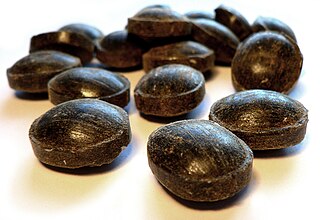
Tyrkisk peber is a salty liquorice candy flavoured with salmiac, produced by the Finnish company Fazer and popular in Northern Europe. Tyrkisk peber was originally invented by Per Fjelsten in 1976 in Jutland, Denmark and was originally made by the Danish company Perelly, before the company was acquired by Fazer.

Salty liquorice, salmiak liquorice or salmiac liquorice, is a variety of liquorice flavoured with the ingredient "salmiak salt", and is a common confection found in the Nordic countries, Benelux, and northern Germany. Salmiak salt gives salty liquorice an astringent, salty taste, akin to that of tannins—a characteristic of red wines, which adds bitterness and astringency to the flavour. Consuming salmiak liquorice can stimulate either a savoury or non-savoury palate and response. Anise oil can also be an additional main ingredient in salty liquorice. Extra-salty liquorice is additionally coated with salmiak salt or salmiak powder, or sometimes table salt.

Liquorice allsorts are assorted liquorice confectionery sold as a mixture. Made of liquorice, sugar, coconut, aniseed jelly, fruit flavourings, and gelatine, they were first produced in Sheffield, England, by Geo. Bassett & Co Ltd.
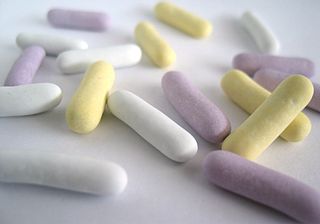
London drops are a type of liquorice candy sold in Finland and Sweden first by Chymos, later by Fazer.

Liquorice or licorice is a confection usually flavoured and coloured black with the extract of the roots of the liquorice plant Glycyrrhiza glabra. A wide variety of liquorice sweets are produced around the world. In North America, black liquorice is distinguished from similar confectionery varieties that are not flavoured and coloured black with liquorice extract but commonly manufactured in the form of similarly shaped chewy ropes or tubes and often called red liquorice. Black liquorice, together with anise extract, is also a common flavour in other forms of confectionery such as jellybeans. In addition to these, various other liquorice-based sweets are sold in the United Kingdom, such as liquorice allsorts. In addition to the sweet variations typically found in the United Kingdom and North America, Dutch, German and Nordic liquorice characteristically contains ammonium chloride instead of sodium chloride, prominently so in salty liquorice, which carries a strong salty rather than sweet flavor.
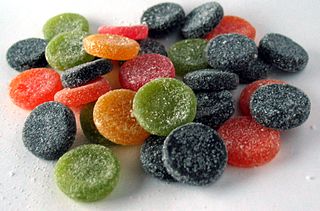
Pantteri, sold in Sweden as Katten, is a brand of Finnish salmiakki candy, made by Fazer.
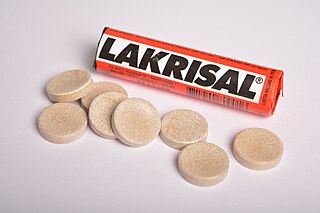
Lakrisal is a Malaco brand of salty liquorice sold in the Nordic countries and the Netherlands.

Trolli is a German manufacturer of confectionery. Its American arm was sold in 1996 and became a confectionery brand used by Ferrara Candy Company. Trolli sells gummy candies, marshmallows, and soft licorice gums in over 80 countries and has factories in Germany, Spain, Indonesia, USA, China and the Czech Republic.
Fruit-tella are chewy sweets similar to Sugus, Starburst and Chewits. They are made using real fruit juice, natural colours and natural flavours, sugar and gelatine. They are made by Perfetti Van Melle, the company that also manufactures Mentos and Chupa Chups.

Midget Gems are chewy, firm sweets similar to wine gums but much harder. They are manufactured from sugar and glucose syrup, corn starch and/or various other starches, animal gelatin, and various colourings and flavouring.
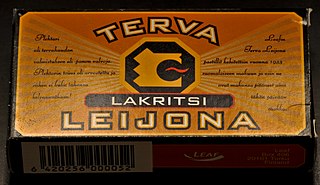
Terva Leijona is a Finnish liquorice candy with tar flavouring. The candy is produced by Cloetta.

Sherbet is a fizzy, sweet powder, usually eaten by dipping a lollipop or liquorice, using a small spoon, or licking it from a finger.

A candy bar is a type of candy that is in the shape of a bar. The most common type of candy bar is the chocolate bar, including both bars made of solid chocolate and combination candy bars, which are candy bars that combine chocolate with other ingredients, such as nuts, caramel, nougat, or wafers.
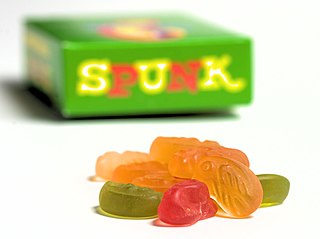
Spunk is a brand of Danish candy, launched in 1971 by Danish candy manufacturers Galle & Jessen and commonly sold in Denmark and Germany.
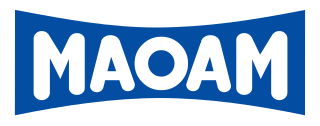
Maoam is a brand of sweets produced by the German confectionery company Haribo. The product name is a century old. The product consists of chewy fruit-flavoured candy in various flavours. A packet of Maoam sweets usually includes five pieces of a particular flavour, and several of these packets are stacked into a stick which is then sold. The sweets are also available in larger packages. Maoams contain gelatine.

Aakkoset is a Finnish brand of candy sold in Finland since 1970, currently sold by Cloetta under the Malaco brand name. The name "Aakkoset" comes from the various capital letters of the alphabet decorating the lozenge-shaped candies.


















